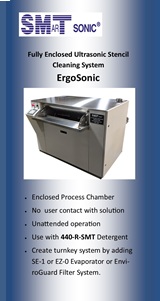|

|
|
| Ask the Experts | |||||||
|
|||||||
|
June 27, 2018 - Updated July 2, 2007 - Originally Posted Cleaning Military Circuit Boards Contaminated with SandWe are repairing military electronic equipment that has been in the field. The circuit boards are contaminated with sand, dirt, grime, sometimes oils, etc. in 60 days. This line does We were considering processing the boards through an aqueous spray cleaner, but have not found a detergent that is compatible with the acrylic coating and can be used in high pressure spray equipment. Any ideas on the best way to clean these boards, especially the removal of sand, without removing the conformal coating. P.T. |
|||||||
| Expert Panel Responses | |||||||
|
Cleaning of this type can effectively be done with a low pressure (25 PSI) wash system with a weak 1% saponifier (either the Kyzen or EnviroGold saponifier) at 125 F wash and ambient rinse a belt speed of 4-5 ft/min and rinse with DI water at low pressure. By using the weak saponifier the surface tension is lowered and has a bit of cleaning energy but not enough to attack the acrylic coating. By using low pressure in wash and rinse will remove the residue but not ablate the surface of the coating. If you want to run ten test boards through this set up please contact me at Foresite. We have been removing field residues on militaryhardware and removing military and avionic coatings for repair for 8 years giveus a call and we can help you set up the appropriate approaches to coatingremoval and cleaning.
President/Senior Technical Consultant Foresite Mr. Munson, President and Founder of Foresite, has extensive electronics industry experience applying Ion Chromatography analytical techniques to a wide spectrum of manufacturing applications.
Acrylic conformal coatings are "thermoplastic" coatings which are used if the coating has to be removed easily or if through-soldering repair should be possible. Acrylic systems can be removed very easy by some solvent especially at higher temperatures as they are thermoplastics. So you have to use a cleaning agent which is not solvent based or which has a very low solvent content and the temperature should be as low as possible. Products that we would recommend would be from the Atron and Vigon product range.
Application Technology Manager Zestron America Mr. Tosun has published numerous technical articles. As an active member of the SMTA and IPC organizations, Mr. Tosun has presented a variety of papers and studies on topics such as "Lead-Free Cleaning" and "Climatic Reliability".
This is a tough question, because most of the cleaners strong enough to remove heavy oils and grime will also begin to damage the conformal coatings. To my mind, the spray wash is taking the solution in the wrong direction. You're going to use lots of water and water-treatment machinery, lots of electricity to wash and then dry, and quite often have problems with quality of the result. Unless you already have the equipment to use, this is a slow and expensive way to clean these boards. My suggestion would be to look at a vapor degreasing option, using a milder solvent that will remove the oils but not damage the conformal coatings. You could, if desired, enhance the cleaning with ultrasonics -- the general prohibition on ultrasonics and PCBs has faded into history as the myth it was. The boards will come out clean, dry and with relatively short cycle times (especially when compared to water-cleaning) which will boost through-put. For solvents, I suggest you check with 3M Novec or DuPont's Vertrel (the latter of which we sell, so my bias is strong). For cleaning machinery, Branson Ultrasonics (818) 707-7001, and Ultronics (800) 553-7881, make excellent machines, as does Tiyoda Serec, 502-212-9226.
Vice President Micro Care Mr. Jones is an electronics cleaning and stencil printing specialist. Averaging over one hundred days a year on the road, Mike visits SMT production sites and circuit board repair facilities in every corner of the globe, helping engineers and technicians work through the complex trade-offs today's demanding electronics require.
I would try a very weak Saponifier solutionbubbled through a cleaning tank to remove the sand and other residues. Thistechnique removes solder powders very efficiently and should be safe on thecoatings
Technical Sales Manager BLT Circuit Services Ltd Greg York has over thirty two years of service in Electronics industry. York has installed over 600 Lead Free Lines in Europe with Solder and flux systems as well as Technical Support on SMT lines and trouble shooting.
Ithink to remove the sand/grime/loose debris, I would use a very low pressuresource (dry) such as nitrogen or even a commercial nonflammable"duster" using 134a or the new HFO 1234ze. This would avertdamaging the coating since low pressure is used and would avoid the blastingeffect. Tofurther clean without damaging the coatings (acrylics are more easily damagedthan urethane), I would recommend a very mild non-alkaline detergent in a batchcleaner. Many aqueous formulas, generally used for defluxing etc, are highlyalkaline and can strip acrylics either by a saponifier or other includedsolvents (often glycol ethers). Many detergents are also alkaline as wellas high foaming. A low foaming surfactant solution can quite possibly clean theremainder of the oils etc as well as any other particulate debris notpreviously removed. I would be glad tospeak with anyone concerning this issue and am always ready to resolve thesetypes of cleaning problems.
Laboratory Mgr. Techspray Pierce Pillon is the Laboratory Manager and lead formulations chemist at Techspray, a division of Illinois Tool Works (ITW) and a leading manufacturer of chemical products for the electronics industry.
|
|||||||
| Submit A Comment | |||||||
|
Comments are reviewed prior to posting. You must include your full name to have your comments posted. We will not post your email address. |
|
Free Newsletter Subscription
Circuitnet is built for professionals who bear the responsibility of looking ahead, imagining the future, and preparing for it. Insert Your Email Address |
|

|





